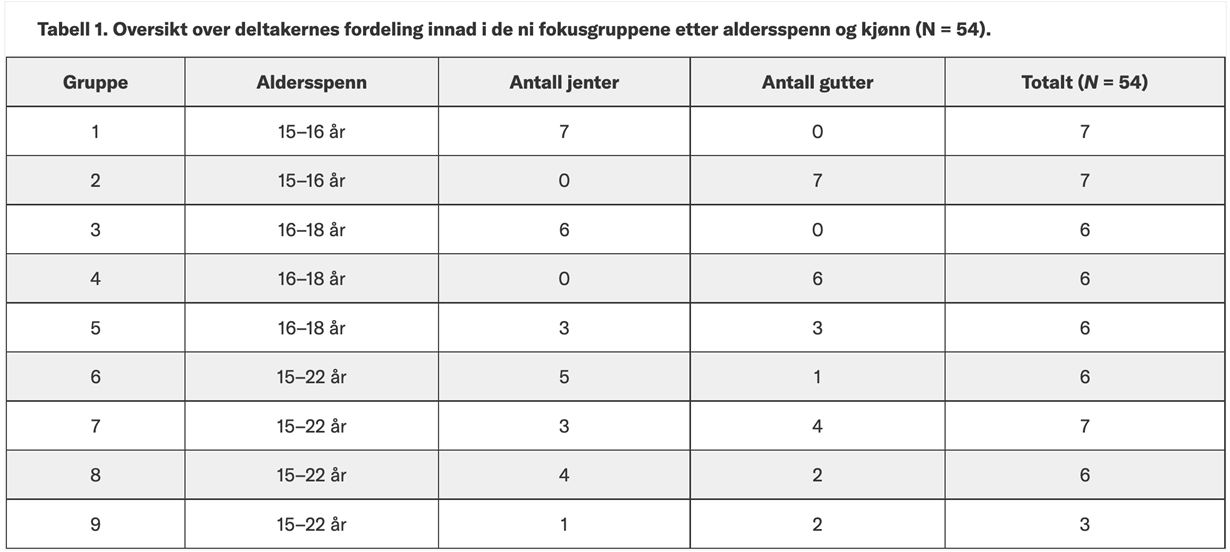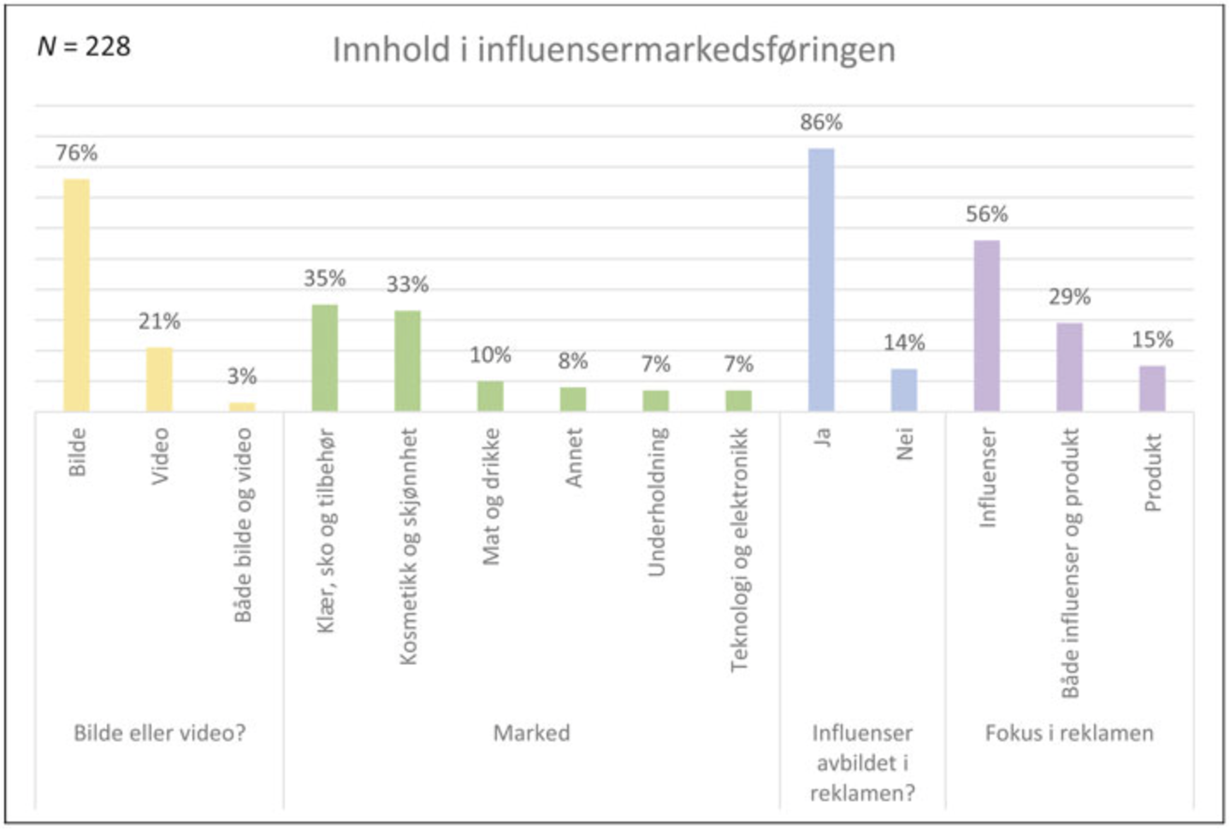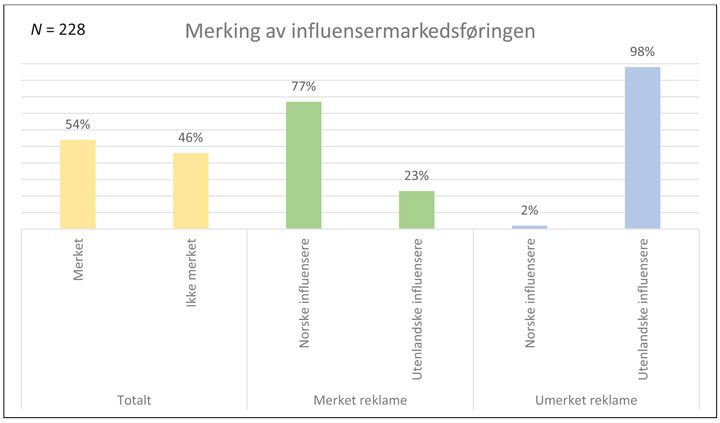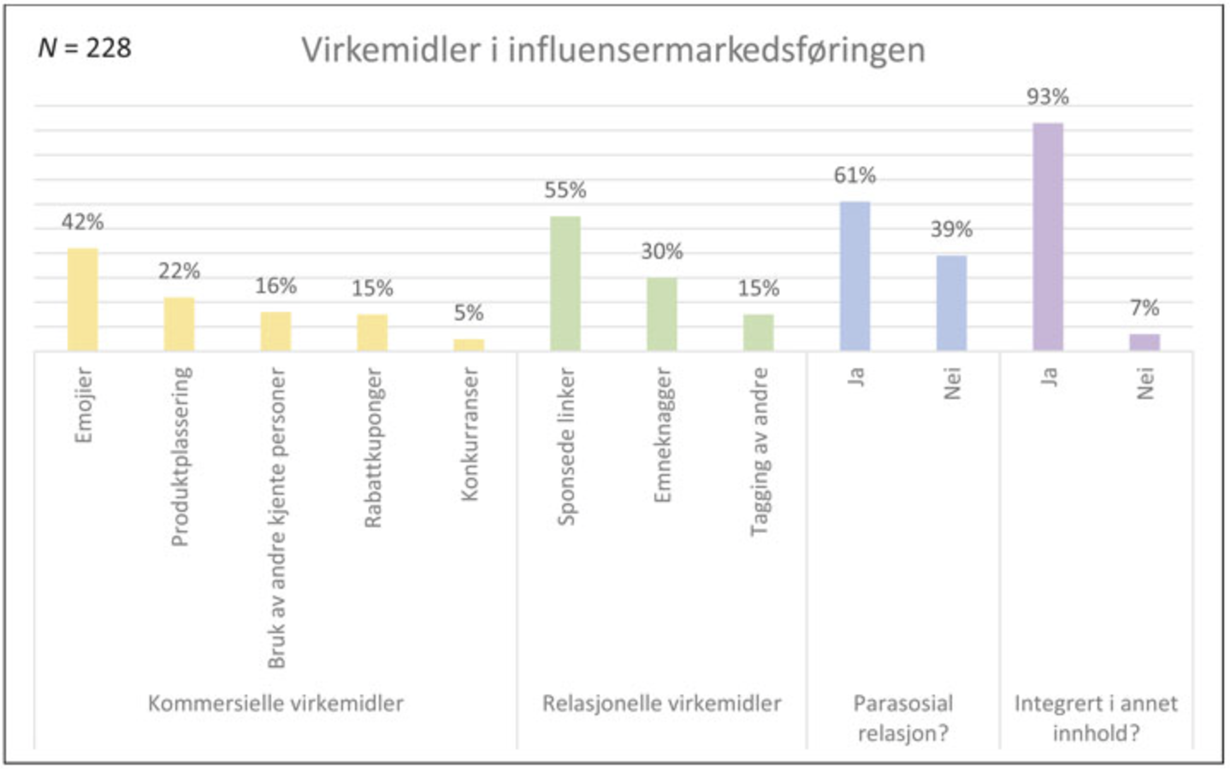Abidin, C. (2015). Communicative <3 intimacies: Influensers and Perceived Interconnectedness. Journal of Gender, New Media, and Technology, (8), 1–16. https://doi.org/10.7264/N3MW2FFG
Abidin, C. & Thompson, E. C. (2012). Buymylife.com: Cyber-femininities and commercial intimacy in blogshops. Women’s Studies International Forum, 35(6), 467–477. https://doi.org/10.1016/j.wsif.2012.10.005
Ames, D. R., Rose, P. & Anderson, C. P. (2006). The NPI-16 as a short measure of narcissism. Journal of Research in Personality, 40(4), 440–450. https://doi.org/10.1016/j.jrp.2005.03.002
Augensen, H., Moen, M. & Lanseng, E. J. (2014). Ærlighet varer lengst: Åpen bloggsponsing er mer effektiv enn skjult. Magma tidsskrift for økonomi og ledelse, 17(3), 58–63.
Bakkeli, N. (2020). Health and economic scarcity: Measuring scarcity through consumption, income and home ownership indicators in Norway. Population Health, 11. https://doi.org/10.1016/j.ssmph.2020.100582
Berg, L., Slettemeås, D., Kjørstad, I. & Rosenberg, T. G. (2020). Trust and the don’t-want-to-complain bias in peer-to-peer platform markets. International Journal of Consumer Studies, 44(3), 220–231. https://doi.org/10.1111/ijcs.12561
Boerman, S. C. & van Reijmersdal, E. A. (2020). Disclosing influenser marketing on YouTube to children: The moderating role of para-social relationship. Frontiers in Psychology, 10(3042). https://doi.org/10.3389/fpsyg.2019.03042
Boyd, D. M. & Ellison, N. B. (2007). Social network sites: Definition, history, and scholarship. Journal of Computer-Mediated Communication, 13(1), 210–230. https://doi.org/10.1111/j.1083-6101.2007.00393.x
Brown, Z. & Tiggemann, M. (2016). Attractive celebrity and peer images on Instagram: Effect on women’s mood and body image. Body Image, 19, 37–43. https://doi.org/10.1016/j.bodyim.2016.08.007
Carr, C. T. & Hayes, R. A. (2014). The effect of disclosure of third-party influence on an opinion leader’s credibility and electronic word of mouth in two-step flow. Journal of Interactive Advertising, 14(1), 38–50. https://doi.org/10.1080/15252019.2014.909296
Childers, C. C., Lemon, L. L. & Hoy, M. G. (2019). #Sponsored #Ad: Agency Perspective on Influenser Marketing Campaigns. Journal of Current Issues & Research in Advertising, 40(3), 258–274. https://doi.org/10.1080/10641734.2018.1521113
Clingingsmith, D. & Sheremeta, R. M. (2017). Status and the demand for visible goods: Experimental evidence on conspicuous consumption. Experimental Economics, 21, 877–904. https://doi.org/10.1007/s10683-017-9556-x
Daloz, J.-P. (2010). The sociology of elite distinction from theoretical to comparative perspectives. London: Palgrave Macmillian.
De Veirman, M., Cauberghe, V. & Hudders, L. (2017). Marketing through Instagram influensers: the impact of number of followers and product divergence on brand attitude. International Journal of Advertising, 36(5), 798–828. https://doi.org/10.1080/02650487.2017.1348035
Ebrahimi, A., Kumano-Ensby, A. L. & Erikstad, V. B. (2020, 19. september). Det påvirkerbransjen ikke viser deg. https://www.nrk.no/dokumentar/xl/det-pavirkerbransjen-ikke-viser-deg-1.15160391
Ellison, N., Heino, R. & Gibbs, J. (2017). Managing impressions online: Self-presentation processes in the online dating environment. Journal of Computer-Mediated Communication, 11(2), 415–441. https://doi.org/10.1111/j.1083-6101.2006.00020.x
Ellison, N., Steinfield, C. & Lampe, C. (2007). The benefits of Facebook ‘friends’: social capital and college students’ use of online social network sites. Journal of Computer-Mediated Communication, 12(4), 1143–1168. https://doi.org/10.1111/j.1083-6101.2007.00367.x
Fardouly, J., Pinkus, R. T. & Vartanian, L. R. (2017). The impact of appearance comparisons made through social media, traditional media, and in person in women’s everyday lives. Body Image, 20, 31–39. https://doi.org/10.1016/j.bodyim.2016.11.002
Fardouly, J. & Vartanian, L. R. (2015). Negative comparisons about one’s appearance mediate the relationship between Facebook usage and body image concerns. Body Image, 12, 82–88.https://doi.org/10.1016/j.bodyim.2014.10.004
Forbrukerrådet. (2019). Ung og utsatt for usunn reklame. Digital markedsføring av mat og drikke ved bruk av influensere. Hentet [05.03.2021] fra https://fil.forbrukerradet.no/wp-content/uploads/2019/02/ung-og-utsatt-for-usunn-reklame-rapport-om-digital-markedsforing-av-mat-og-drikke-28-februar-2019.pdf
Forbrukertilsynet. (2020, 19. februar). Digitale tjenester og forbrukeres personopplysninger. Veiledning. Hentet fra https://www.forbrukertilsynet.no/lov-og-rett/veiledninger-og-retningslinjer/digitale-tjenester-og-forbrukeres-personopplysninger
Freberg, K., Graham, K., McGaughey, K. & Freberg, L. A. (2011). Who are the social media influensers? A study of public perceptions of personality. Public Relations Review, 37(1), 90–92. https://doi.org/10.1016/j.pubrev.2010.11.001
Hartmann, T. & Goldhoorn, C. (2011). Horton and Wohl revisited: Exploring viewers’ experience of parasocial interaction. Journal of Communication, 61(6), 1104–1121. https://doi.org/10.1111/j.1460-2466.2011.01595.x
Herring, S. C. & Kapidzic, S. (2015). Teens, gender, and self-presentation in social media. I J. D. Wright (Red.), International Encyclopedia of the Social & Behavioral Sciences (2. utg, s. 146–152). Oxford: Elsevier.
Hilmarsen, H. V. & Arnseth, H. C. (2017). Livet på Instagram. Ungdoms digitale forlengelser av sosiale relasjoner og vennskap. Tidsskrift for ungdomsforskning, 17(1), 3–23.
Hogue, J. V. & Mills, J. S. (2019). The effects of active social media engagement with peers on body image in young women. Body Image, 28, 1–5. https://doi.org/10.1016/j.bodyim.2018.11.002
Jin, S. V., Muqaddam, A. & Ryu, E. (2019). Instafamous and social media influenser marketing. Marketing Intelligence & Planning, 37(5), 567–579. https://doi.org/10.1108/MIP-09-2018-0375
Ki, C.-W., Cuevas, L. M., Chong, S. M. & Lim, H. (2020). Influenser marketing: Social media influensers as human brands attaching to followers and yielding positive marketing results by fulfilling needs. Journal of Retailing and Consumer Services, 55. https://doi.org/10.1016/j.jretconser.2020.102133
Kjeldsen, J. E. (2004). Retorikk i vår tid: en innføring i moderne retorisk teori. Oslo: Spartacus.
Klepp, I. G., Laitala, K. & Skuland, S. (2019). Uniformity without uniforms: Dressing school children in Norway. I A. Borch, I. Harsløf, K. Laitala & I. G. Klepp (Red.), Inclusive consumption. Immigrants’ use and access to public and private goods and services (s. 154–166). Oslo: Universitetsforlaget.
Li, Y. M., Lai, C. Y. & Chen, C. W. (2011). Discovering influensers for marketing in the blogosphere. Information Sciences, 181(23), 5143–5157. https://doi.org/10.1016/j.ins.2011.07.023
Liu, S., Jiang, C., Lin, Z., Ding, Y., Duan, R. & Xu, Z. (2015). Identifying effective influensers based on trust for electronic word-of-mouth marketing: A domain-aware approach. Information Sciences, 306, 34–52. https://doi.org/10.1016/j.ins.2015.01.034
Liu, R. & Suh, A. (2017). Self-branding on social media: An analysis of style bloggers on instagram. Procedia Computer Science, 124, 12–20. https://doi.org/10.1016/j.procs.2017.12.124
Lou, C. & Yuan, S. (2019). Influenser marketing: How message value and credibility affect consumer trust of branded content on social media. Journal of Interactive Advertising, 19(1), 58–73. https://doi.org/10.1080/15252019.2018.1533501
Markedsføringsloven. (2009). Lov om kontroll med markedsføring og avtalevilkår mv. (LOV-2020-06-23-98). Hentet fra https://lovdata.no/lov/2009-01-09-2
Marwick, A. E. (2015). Instafame: Luxury selfies in the attention economy. Public Culture, 27(1), 137–160. https://doi.org/10.1215/08992363-2798379
Medienorge. (2018, 11.02.2021). Reklameomsetning via mediebyråer. Hentet fra: http://medienorge.uib.no/statistikk/medium/avis/170
Medietilsynet. (2020). Barn og medier 2020. Om sosiale medier og skadelig innhold på nett. Delrapport 1, 11. februar 2020 (Barn og medier 2020: Delrapport 1). Hentet [05.03.2021] fra https://medietilsynet.no/globalassets/publikasjoner/barn-og-medier-undersokelser/2020/200211-barn-og-medier-2020-delrapport-1_-februar.pdf
Nam, K., Baker, J., Ahmad, N. & Goo, J. (2020). Determinants of writing positive and negative electronic word-of-mouth: Empirical evidence for two types of expectation confirmation. Decision Support Systems, 129. https://doi.org/10.1016/j.dss.2019.113168
Perloff, R. M. (2014). Social media effects on young women’s body image concerns: Theoretical perspectives and an agenda for research. Sex Roles, 71(11), 363–377. https://doi.org/10.1007/s11199-014-0384-6
Rasmussen, L. L. (2018). Parasocial Interaction in the Digital Age: An Examination of Relationship Building and the Effectiveness of YouTube Celebrities. Social media and Society, 7(1), 280–294.
Reinikainen, H., Munnukka, J., Maity, D. & Luoma-aho, V. (2020). ‘You really are a great big sister’ – parasocial relationships, credibility, and the moderating role of audience comments in influenser marketing. Journal of Marketing Management, 36(3–4), 279–298. https://doi.org/10.1080/0267257X.2019.1708781
Rosenberg, J. & Egbert, N. (2011). Online impression management: Personality traits and concerns for secondary goals as predictors of self-presentation tactics on Facebook. Journal of Computer-Mediated Communication, 17(1), 1–18. https://doi.org/10.1111/j.1083-6101.2011.01560.x
Rosenberg, T. G., Steinnes, K. K. & Storm-Mathisen, A. (2018). Markedsføring og personvern i sosiale medier – en flermetodisk undersøkelse med barn som medforskere (Forskningsrapport SIFO, 13–18). Hentet [05.03.2021] fra http://hdl.handle.net/20.500.12199/1310
Rysst, M. (2019). Consumption practices and social inclusion among children in Lillehammer. I A. Borch, I. Harsløf, K. Laitala & I. G. Klepp (Red.), Inclusive consumption. Immigrants’ use and access to public and private goods and services (s. 154–166). Oslo: Universitetsforlaget.
Rysst, M. (2020). Popularity, gender and social inclusion among girls in ethnic diverse contexts in Norway. International Journal of Child, Youth and Family Studies, 11(1), 46–70. https://doi.org/10.18357/ijcyfs111202019473
Skuland, S. E. (2019). Packed lunch poverty: Immigrant families’ struggles to include themselves in Norwegian food culture. I A. Borch, I. Harsløf, K. Laitala & I. G. Klepp (Red.), Inclusive consumption. Immigrants’ use and access to public and private goods and services (s. 135–152). Oslo: Universitetsforlaget.
Steinnes, K. K., Teigen, H. F. & Bugge, A. B. (2019). Photoshop, fillers og falske glansbilder? En studie blant ungdom om kjønn, kropp og markedsføring i sosiale medier. (Forskningsrapport SIFO, 3–19). https://hdl.handle.net/10642/9033
Stubb, C., Nyström, A.-G. & Colliander, J. (2019). Influenser marketing: The impact of disclosing sponsorship compensation justification on sponsored content effectiveness. Journal of Communication Management, 23(2), 109–122. https://doi.org/10.1108/JCOM-11-2018-0119
Taylor, D. G. & Strutton, D. (2016). Does Facebook usage lead to conspicuous consumption? The role of envy, narcissism and self-promotion. Journal of Research in Interactive Marketing, 10(3), 231–248. https://doi.org/10.1108/JRIM-01-2015-0009
Thoumrungroje, A. (2014). The influence of social media intensity and EWOM on conspicuous consumption. Procedia – Social and Behavioral Sciences, 148, 7–15. https://doi.org/10.1016/j.sbspro.2014.07.009
Throne-Holst, H. & Kjørstad, I. (2016). Hva koster gratis? Kommersiell bruk av personopplysninger og forbrukerdata. (Forskningsrapport SIFO, 11–16). http://hdl.handle.net/20.500.12199/5333
Veblen, T. (1899). The theory of the leisure class: An economic study in the evolution of institutions. New York, NY: Macmillan.
Veum, A. (2013). Blogging på rosa skjerm: Om roller og relasjoner i ungjentebloggar. I S. Hållsten, H. S. Rehnberg & D. Wojahn (Red.), Text, kontext och betydelse: sex nordiska studier i systemisk-funktionell lingvistik (s. 107–124). Huddinge: Södertörns högskola.
Vogel, E. A., Rose, J. P., Roberts, L. R. & Eckles, K. (2014). Social comparison, social media, and self-esteem. Psychology of Popular Media Culture, 3(4), 206–222. https://doi.org/10.1037/ppm0000047
Walton, M. & Pallitt, N. (2012). ‘Grand Theft South Africa’: games, literacy and inequality in consumer childhoods. Language and Education, 26(4), 347–361. https://doi.org/10.1080/09500782.2012.691516
Aalen, I. (2015). Sosiale medier. Bergen: Fagbokforlaget.





